
Analysis: Top Selling Products Amid the Coronavirus Crisis – How Demand Is Shifting
Zoë MacDonald, March 24, 2020
Much has changed in one month’s time.
Since WHO updated the COVID-19 outbreak from a ‘global emergency’ to a ‘global pandemic’ earlier this month, the virus’ spread and the world’s efforts to contain it have meant some dramatic changes in our everyday lives.
The following analysis is based on quantitative and qualitative surveys, anonymized aggregated data as well as complex analytical models.
We set out to answer how the coronavirus pandemic has so far affected Amazon online shopping in two parts:
Looking at one of the countries most hard-hit by COVID-19, Italy: How is demand developing?
What are people buying across different marketplaces (US, Germany, and Italy)? Which products are the ‘winners’ in the current situation?
What are Americans buying on Amazon since the COVID-19 pandemic hit?
For meaningful insights at a glance, download our ‘Top & Flop 50 Products on Amazon.com: Shopping Trends During the Coronavirus Crisis’ analysis.
The Economic Impact of the Coronavirus Pandemic
With the coronavirus pandemic affecting primarily China in the early part of the year, Amazon brands sourcing products from the production powerhouse anticipated the most significant economic impact being on supply.
With countless factories in affected areas shutting down completely, Amazon businesses were (rightfully) concerned that this hit to the supply chain could mean a low stock and ultimately selling out of product. Knowing, of course, that one of the worst things that you can be on Amazon is ‘sold out’.
Even with factories partly operational, with strict limitations on outside contact affecting trade: little came in and little came out.
And because Amazon’s A9 algorithm weights recent activity more heavily, lost sales means a slipping rank - one that could start a negative momentum for your hard-earned place in Amazon’s search results.
By late February, reports indicated that Chinese factories were slowly getting back to business. But as the global situation has evolved, so too have the concerns of forward-thinking Amazon merchants and our own calls to action as global citizens.
From a general call to practice social distancing to school closures and in some extreme cases a full-on ‘lockdown’, we are all now encouraged to stay indoors to preserve the health of our communities.
In the meantime, Amazon has done their best to keep up with the changing environment so that it may continue to serve its customers - maybe while the platform is needed most:
By discouraging opportunistic gouging with harsh penalties, dramatically increasing fulfillment capacity, and prioritizing household staples, medical supplies, and other high-demand products for FBA.
Shifting Gears: Concern Over COVID-19's Impact on Demand
So what ultimately do these changes mean for the biggest (online) store in the world?
Possibly, an increase in demand. Some are speculating that these changes could catapult eCommerce into the future by encouraging habitually in-store-purchasing hold-outs to cross over to online out of necessity.
After all, shoppers who become accustomed to getting staples online might be unlikely to switch back to in-store buying when post-COVID-19 normalcy is restored. Shopping online could become the new normal for most consumers.
And yet, facing the reality of a changing economy, the risks to Amazon businesses are now not quite so clear cut.
While consumers have both the time and the necessity to shop online, the imperative to stay indoors for the foreseeable future will naturally limit demand for certain product categories.
Moreover, as the economic situation remains uncertain and is likely to continue to decline (at least in the short term) concerns have shifted to demand.
In a recent survey of Sellics users, 48% report already seeing a decrease in demand.
Impact on Demand

Source: Sellics
Whether prospective customers buy more or less overall depends on whether the surge in shopping online can compensate for a widespread decrease in buying power.
We can’t help but speculate about what the future will bring and how the current circumstances will reform eCommerce as we know it. And since we don’t have a crystal ball, we are turning to the next best thing: data.
Are Consumers Shopping More or Less on Amazon in Light of the Coronavirus Pandemic?
For answers, we turned to one of Amazon’s marketplaces hardest hit by the coronavirus pandemic, Italy, to see how online shopping demand is developing there.
Estimate Sales Growth: Italy
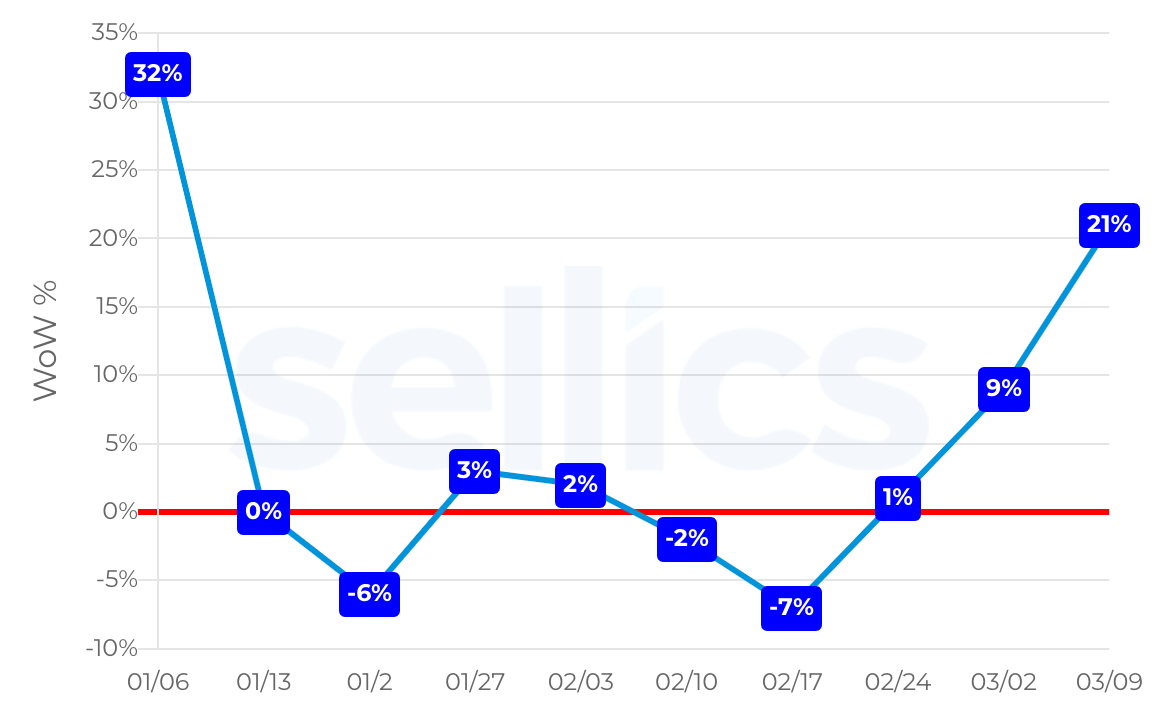
Source: Sellics
For context, the drop at the beginning of the chart is normal for January. After a flurry of spending near the end of the year, buying tends to settle during the first month. What is remarkable is the incline in the latest third.
If we can use Italy’s trajectory as an indication, the serious calls to action for social distancing and state-official closures could lead to a relatively steep incline in Amazon sales.
Indeed, the growth rate represented appears to be in sync with these changes as limited quarantines began in Italy by the 23rd of February, and on March 9th, a lockdown was extended nationwide.
Of course, to say anything with statistical certainty, more data is needed.
While it is too early to draw any definitive conclusions at this point, this early data does suggest the possibility of an increase in demand for marketplaces which are now facing similar social distancing measures.
But that people are shopping online is only half of the picture. To get a better understanding of the commerce situation on Amazon and what Vendors and Sellers should expect, we have to dive into what people are buying online.
What Are They Buying? COVID-19 Online Shopping Trends
Now, we understand that Italy’s current situation is likely to have profoundly affected shopping behavior on Amazon, both in terms of demand and product selection.
But where there is a strong awareness of the threat of the coronavirus in the United States and Germany, we can already observe significant changes in the demand for certain products.
To highlight only the strongest trends, we have identified the top five main categories for each marketplace.
COVID-19 Online Shopping: Top 5 Main Categories
US
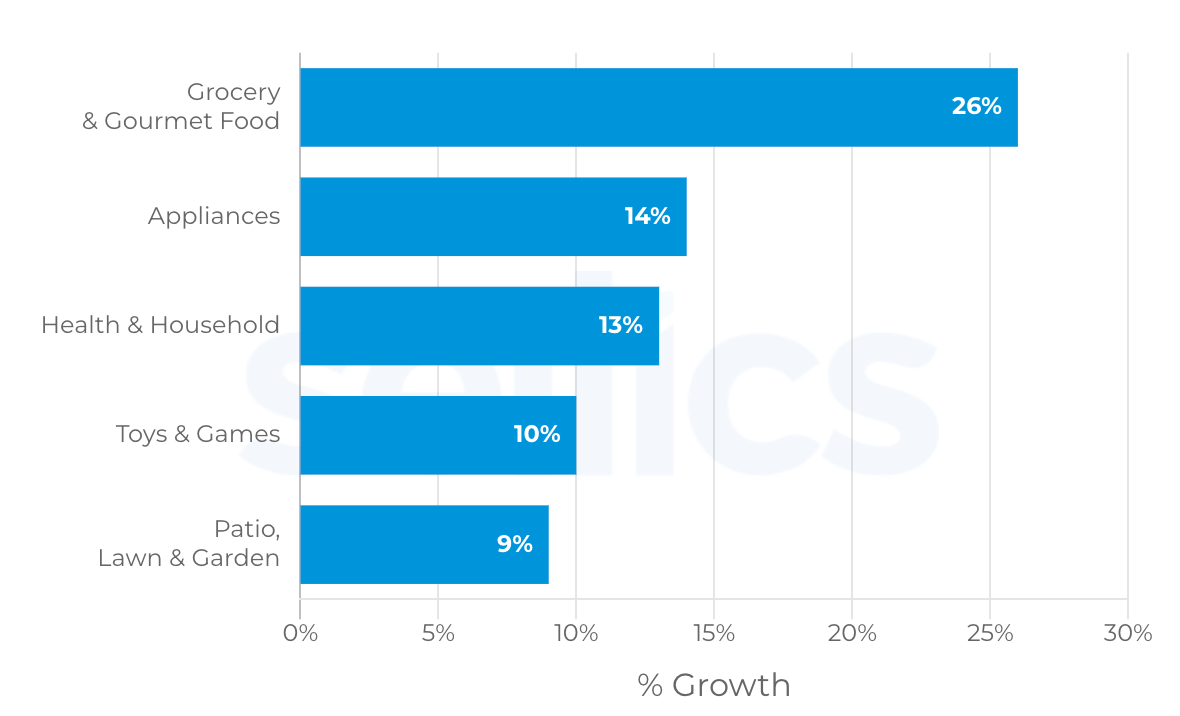
WoW Growth % From 02.03.2020 to 09.03.2020 - Source: Sellics
Germany
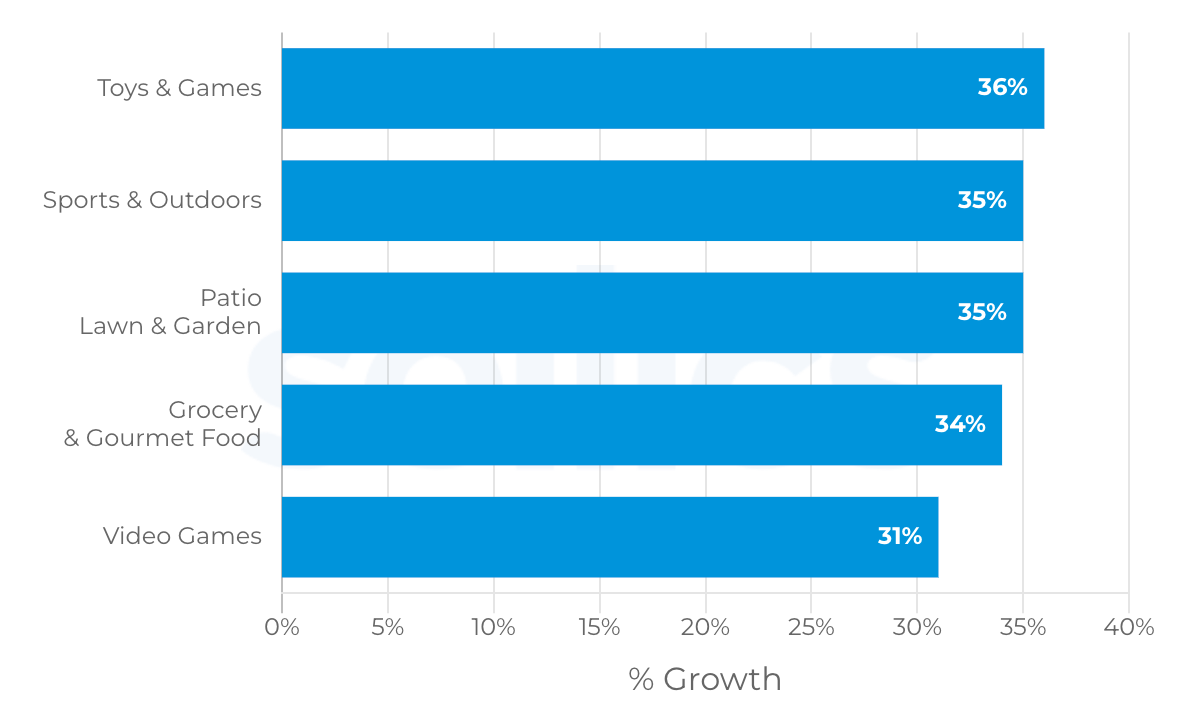
WoW Growth % From 02.03.2020 to 09.03.2020 - Source: Sellics
Italy
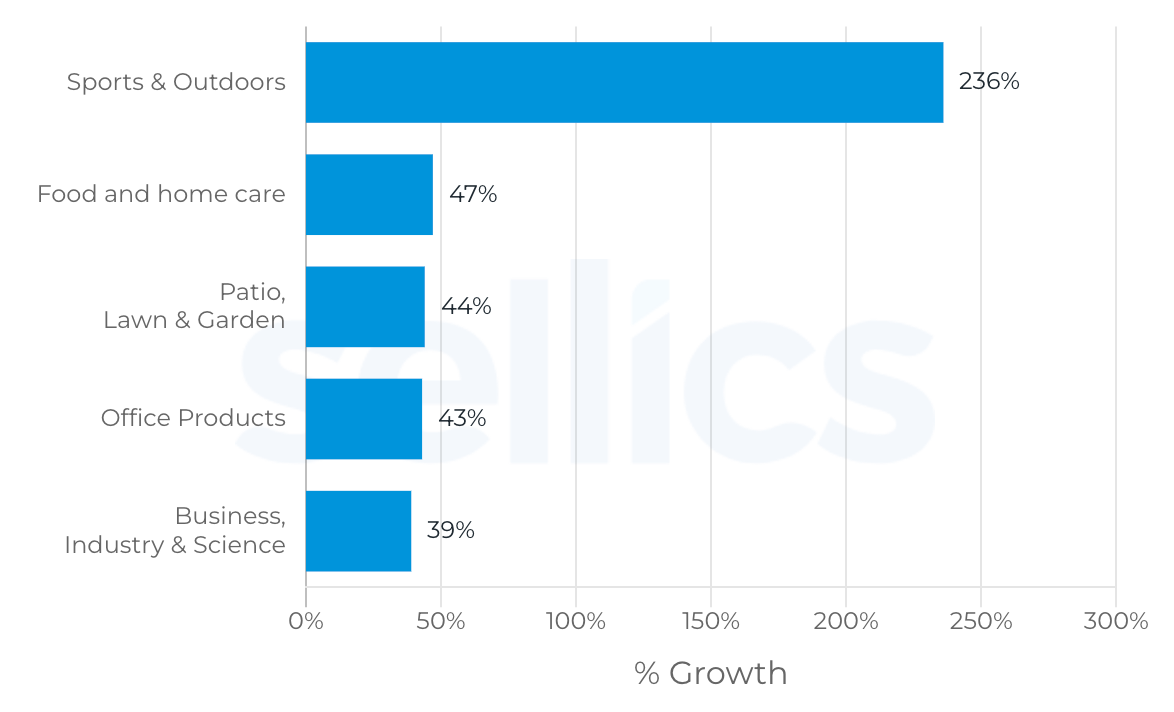
WoW Growth % From 02.03.2020 to 09.03.2020 - Source: Sellics
In Italy, in addition to significant market growth, we also see the most pronounced growth by percentage in ‘trending’ categories.
Notably, ‘Sports & Outdoors’ grew significantly in both German and Italian markets, but Italy saw a growth rate 674% higher than the German market’s did.
This hints that already established trends are likely to continue while the US and Germany now face increased home isolation.
Observable shopping trends in the US, Germany, and Italy so far include:
Groceries & Home Basics
Survival Shopping
Backyard Betterment
Entertainment & Activities
Indoor Fitness & (Solo) Outdoor Sports
Home Office
Bringing the Outside In
COVID-19 Online Shopping Trend #1: Groceries & Home Basics
There are two ways of understanding the surge in online grocery shopping:
As ‘replacement shopping’: purchases that are likely to have been made off Amazon (at a brick and mortar store) before the urgency to stay at home was introduced.
For ‘stocking up’ on essentials, especially non-perishables both for reasons of both security and to limit the frequency or necessity of future shopping trips.
Food and home care (+47% in Italy)
Grocery & Gourmet Food (+26% in US, +34% in Germany)
COVID-19 Online Shopping Trend #2: Survival Shopping
Survival shopping means items that have an intuitive link between the virus and the demand for the product. More generally, medical supplies, and more specifically, e.g. air purifiers:
Health & Household (+13% in the US)
Health & Personal Care (+19% in Germany*)
Appliances (+14% in the US) - mainly driven by air purifiers (+74%)
Business; Industry & Science (+39% in Italy - with the subcategory ‘Health and Safety Products’ +98%)
COVID-19 Online Shopping Trend #3: Backyard Betterment
Many might be inspired to divert funds usually spent on being out to spruce up their space. Especially as springtime vacation plans are canceled, no doubt Amazon customers are coming up with creative ways of making the most of their time spent in their own homes.
Shoppers are demonstrating a desire to invest in their home and backyard, by purchasing things like gardening supplies:
Patio, Lawn & Garden (+44% in Italy, +35% in Germany, +9% in US)
We expect that this trend will strengthen as the travel restrictions tighten.
COVID-19 Online Shopping Trend #4: Entertainment & Activities
Perhaps the least surprising trend of the lot, people are of course looking for ways to entertain themselves with the means that they have available.
Video Games (+31% in Germany)
Toys & Games (+10% in US, +36% in Germany, +30% in Italy**)
A glance at the subcategories seeing the most growth in each market suggests that shoppers are also looking to create and connect: We’ll get into that in a bit.
COVID-19 Online Shopping Trend #5: Indoor Fitness and (Solo) Outdoor Sports
One thing which these three markets undoubtedly share is a love for sports.
That, and understanding that social distancing doesn’t strictly mean staying indoors, means purchases for ‘outdoor’ sports that can be done solo or require limited contact are a popular option.
Sports & Outdoors (+236% in Italy, +35% in Germany)
Indoor fitness equipment is of course also popular as consumers are forced to forego trips to the gym.
We expect that this trend will continue as sporting events cancelations now ramp up in the USA and Germany.
COVID-19 Online Shopping Trend #6: Home Office
In the US, though orders and regulations varied quite a bit by state, for the most part, major moves such as (mandatory) school and business closures were announced between the 13th and the 16th of March - around the same time the CDC issued a recommendation that events exceeding 50 people should be canceled.
Germany’s school closures followed roughly the same timeline, with closures announced on the 13th and implemented on the 16th of March for all states.
In both markets, business closures trickled in shortly after with a slightly messier timeline, coming in waves with pre-emptive/voluntary closures or work-from-home mandates mixed in.
Save to say, few felt the urgency to work from home before the 13th in these markets. Of course, those dates are not yet represented in this data set (which is following purchasing trends until the 9th of March).
That being said, it’s plain to see that in Italy, where isolation has forced those who can to bring their work inside the home, outfitting the space will be a natural place to invest:
Office Products (+43% in Italy)
We’re identifying this trend now because we have every reason to expect that it will follow shortly for Germany and the USA.
COVID-19 Online Shopping Trend #7: Bringing the Outside In
Customers are making purchases with the understanding that they are about to spend a lot more time indoors.
Like ‘replacement shopping’ for groceries, but taken much more broadly. Consumers are naturally looking to bring the outside world in: To purchase products which help them keep up their regular ‘outside’ activities in their own homes.
What precisely this means will be differ by culture. To shed some light, let’s get started with subcategories.
COVID-19 Online Shopping: Top Selling Sub-Categories
We have already touched on the ways that the relevant subcategories can provide clearer insights into which products are driving these larger categorical trends, but let’s now get into more detail, with the top ten sub-categories for each market.
As a matter of fact, a closer look at the sub-categories validates the identified trends. At the same time, this more detailed view reveals more than a difference in the coronavirus spread and prevention measures timeline, exposing some cultural nuances. As such, we’ll take these on by marketplace.
Top 10 Subcategories: United States
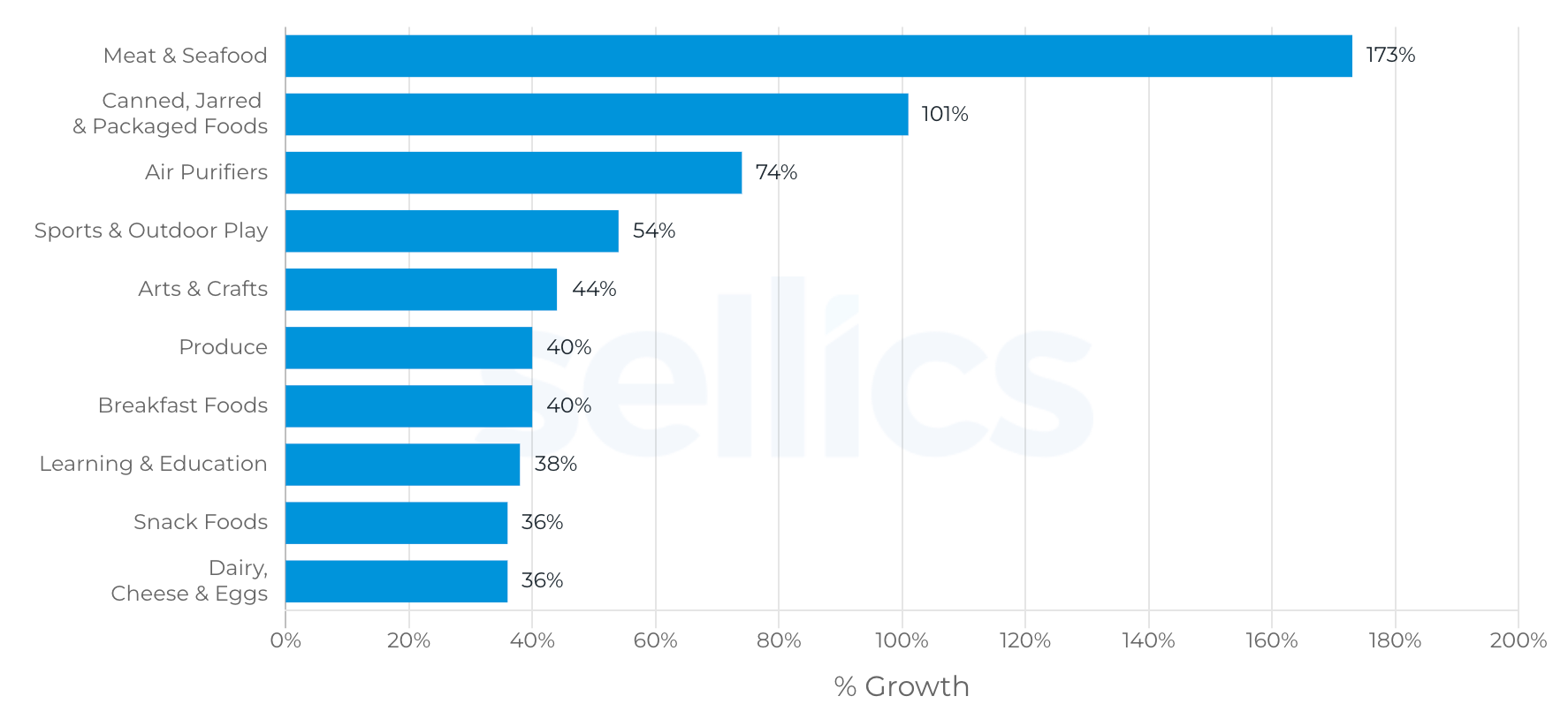
WoW Growth % From 02.03.2020 to 09.03.2020 - Source: Sellics
In the American market, there is a clear online shopping trend toward groceries, for both perishable and fresh food products (#1):
Meat & Seafood (+173%)
Canned, Jarred & Packaged Foods (+101%)
Produce (+40%)
Breakfast Foods (+36%)
Snack Foods (+36%)
Dairy, Cheese & Eggs (+36%)
We are also seeing significant growth in the purchase of air purifiers (#2), up 74%. This makes sense in the context of a growing conscientiousness for health and the air that we breathe.
Looking to stay fit and have fun, outdoor sports are a go-to for American shoppers contemplating spending more time close to home (#5):
Sports & Outdoor Play (+54%)
And finally, to pass the time in the great indoors, (#4) in this case likely with children in mind, some consumers are investing in creative and educational activities to stay busy:
Arts & Crafts (+44%)
Learning & Education (+38%)
Top 10 Subcategories: Germany

WoW Growth % From 02.03.2020 to 09.03.2020 - Source: Sellics
Evidently demonstrating a focus on fitness and entertainment, while the German market looks to have participated in the grocery shopping trend they did less so than the United States. Also, based on what they purchased, (Rice & legumes +160%) they are likely to have been ‘stocking up’ rather than replacing their grocery store routine.
That fact might be attributable to the abundance of grocery stores in Germany. Despite the fact that the United States has an approximately four times larger population, both countries have between about 35,000 and 40,000 grocery stores.
With a grocery store on every corner, it’s possible that German consumers remain comfortable stocking up locally (at least for now) while being able to avoid transit or traveling too far from home by car.
If you didn’t know, you do now: Table tennis (+209%), or ping pong, is something of a national obsession in Germany. With tables most often installed in public places, there is a newfound need to bring this hobby home (#7).
Other outdoor sporting activities (#5) showing significant growth include:
Sport & outdoor (+160%)
Basketball (86%)
Inline skates & roller skates (72%)
Fitness (+76%)
Skateboarding (53%)
Similar to the United States growth in ‘Arts & Crafts’, German consumers showed an increased interest in ‘Crafts & Painting’ (+92%) (#4).
Finally, for a piece of paradise in one’s own backyard (#3):
Pools, garden saunas & whirlpools (+88%)
Grills & equipment (+55%)
Top 10 Subcategories: Italy
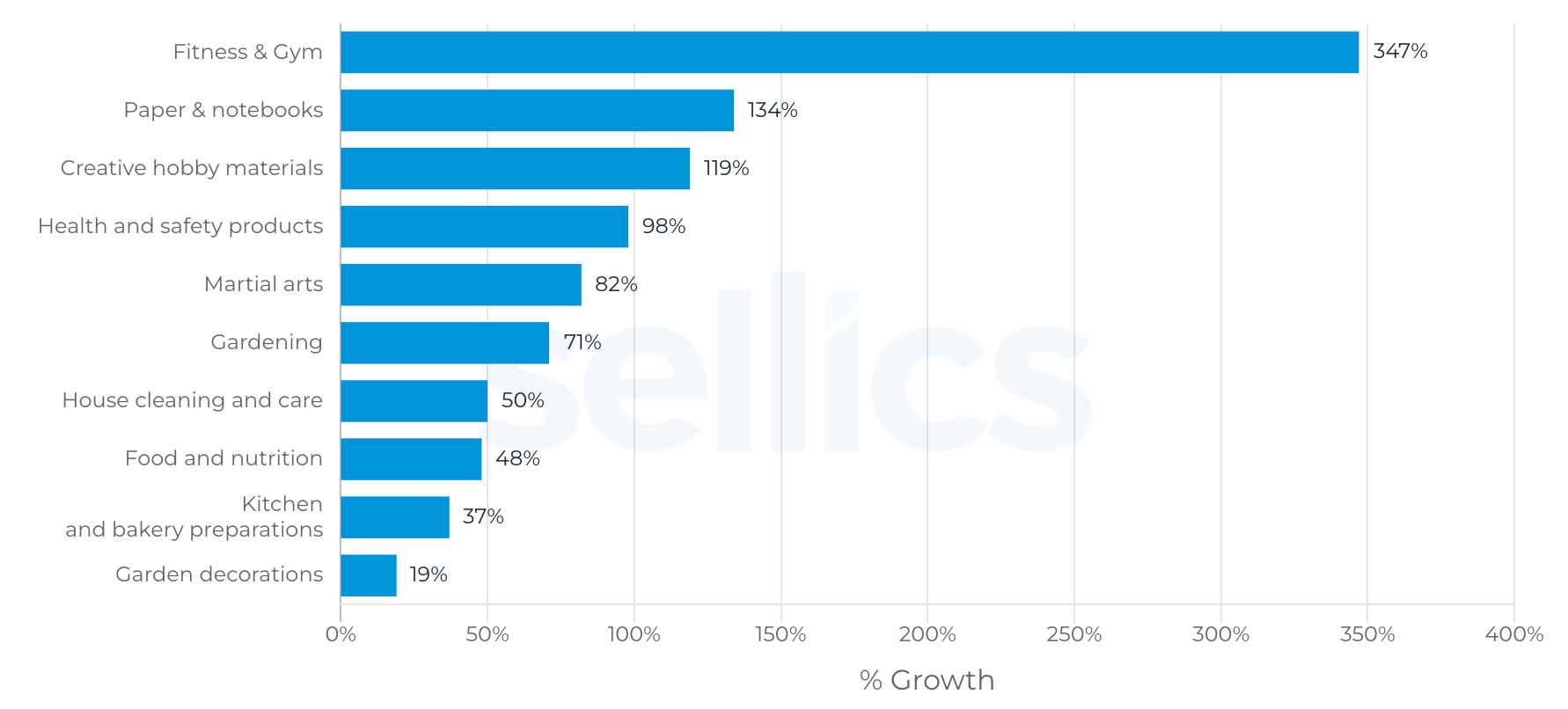
WoW Growth % From 02.03.2020 to 09.03.2020 - Source: Sellics
With the most strict imperative for Italian consumers to stay inside, it makes sense that they should want to invest in fitness and (home) gym (+347%, #5) for basic exercise.
And, like Germany’s table tennis obsession, growth in the Martial arts category (+82%) reflects the widespread popularity and tradition of Italian martial arts and the desire to bring a once public activity indoors (#7).
All three markets share an interest in crafts, (#4) with Creative and hobby materials seeing 119% growth in Italy as well as Paper & notebooks (+134%).
Because more Italian citizens are having to cope with the infection of COVID-19, it is no surprise that Health and safety products continue to grow (+98%, #2).
Ordering groceries online is likely to have become a necessity for some, with the possibility of baking doing double duty as a pastime (#1 & #4):
Food & nutrition (48%)
Kitchen and bakery preparations (+37%)
Finally, basic necessities for the home (#1) and yard (#3), with the possibility of hobby gardening (#4):
Gardening (+71%)
House cleaning and care (+50%)
Garden decorations (+19%)
Conclusion: COVID-19 Economic Predictions
It appears that the demand for eCommerce in the midst of the coronavirus pandemic will increase - at least for many product areas. What we can’t now know for certain is how changes to the global economy will factor in.
And, though we don’t know what precisely will be done, it is clear that as the largest online retailer in the western world, Amazon will be quick to respond to the crisis as needed.
In perhaps one of the most drastic changes to the platform so far, Amazon announced on Saturday that it will limit orders of non-essential products to two of the hardest-hit countries in Europe, Italy, and France, in an effort to keep up with the demand and delivery of essential goods.
Such changes will, of course, represent a short term hit for most sellers and vendors but are likely to support the greater good for health and economic growth in the long term, hopefully encouraging quicker national socio-economic recoveries from the devastation of COVID-19.
For now, we expect that the trends we have observed so far will hold. We expect that shoppers will continue to:
Replace visits to local stores for essentials with a digital trip to Amazon
Stock-up on items that help combat the spread of COVID-19
Bring the outside in by investing in their home space with household improvements and entertainment
Naturally, over a long period and as the situation changes for countries around the world, shopping trends will continue to evolve and we expect further demand changes depending on the evolution of the coronavirus crisis. As such, we are keeping a keen eye for insights that can be gleaned and shared.
On that note, for answers, educational resources, and meaningful conversations around the Amazon and E-Commerce space, check in on our Webinars page where we will be posting new sessions regularly. For regular updates on the coronavirus pandemic and its impact on Amazon, eCommerce and online shopping, check-in here.
* – As Health & Personal care is the sixth-largest growth category, it does not feature on the chart above.
** – Toys & Games is the 7th largest growth Category in Italy.
To get started or learn more about how Perpetua can help you scale your Amazon Advertising business, contact us at hello@perpetua.io